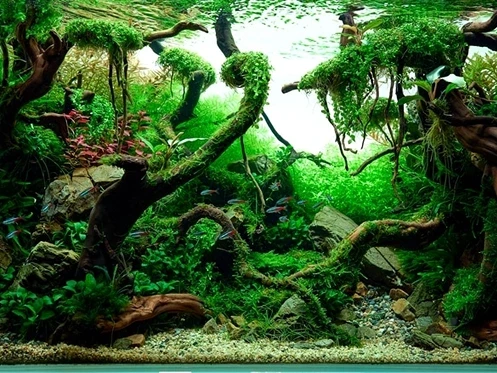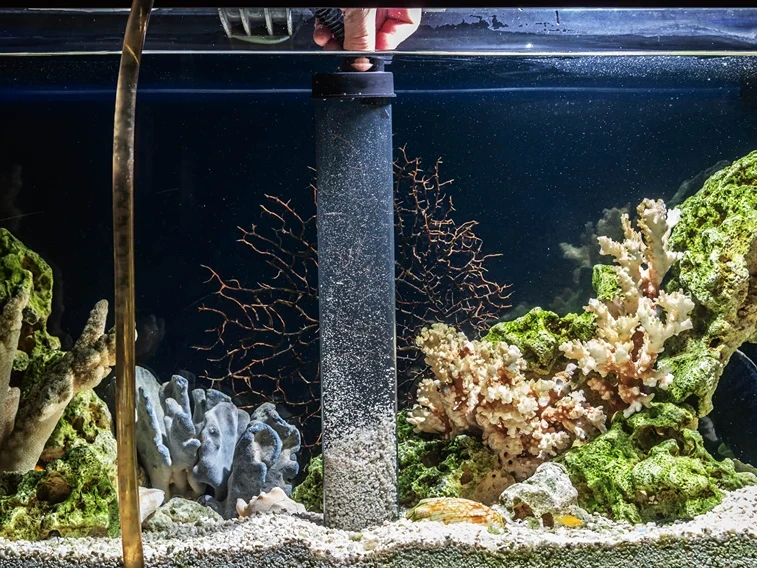Water quality is a pivotal aspect of maintaining healthy aquatic environments, whether it be a freshwater aquarium, a saltwater tank, or an outdoor pond. The balance of various water parameters not only ensures the thriving of aquatic life but also prevents common issues that can arise from imbalanced conditions. In this article, we’ll delve into the essential water parameters for aquatic life, focusing on the needs within the United Kingdom, and provide insights into maintaining these parameters for the health and longevity of your aquatic inhabitants.
Jump to:
Key Takeaways
- Importance of maintaining ideal pH levels, temperature, dissolved oxygen, and the nitrogen cycle for aquatic health.
- Specific needs for freshwater and saltwater aquariums, including water hardness and carbonate hardness (KH).
- Seasonal variations and their impact on outdoor ponds and habitats.**
- Advanced water testing techniques and common issues with solutions.**
Register for our latest in-depth reviews and product round-ups from the experts
Enter your email address below to receive our twice monthly reviews emails.
By entering your details, you are agreeing to our terms and conditions and privacy policy. You can unsubscribe at any time.
Introduction to Water Parameters
The foundation of a thriving aquatic environment lies in the understanding and management of key water parameters. These include pH levels, temperature, dissolved oxygen, and elements of the nitrogen cycle such as ammonia, nitrites, and nitrates. Each parameter plays a crucial role in the ecosystem, affecting everything from the health of the fish to the growth of plants and bacteria.
Essential Water Parameters for Aquatic Life

pH Levels: The Role in Aquatic Health
The pH level of water measures its acidity or alkalinity, which can significantly affect the health of aquatic organisms. Most freshwater fish thrive in a pH range of 6.5 to 7.5, while saltwater species prefer a slightly alkaline environment of 8.1 to 8.4. It’s crucial to regularly monitor and adjust the pH to suit the specific needs of your aquatic life.
Temperature: Effects on Aquatic Organisms
Temperature stability is vital for the well-being of aquatic species. Tropical fish, for example, require warmer water temperatures between 24°C to 28°C, whereas cold-water species like goldfish thrive in temperatures from 20°C to 23°C. Sudden temperature changes can stress or even fatally harm aquatic life, making a reliable heating and cooling system essential for any aquarium or pond.
Dissolved Oxygen: Crucial for Aquatic Life Survival
Dissolved oxygen is necessary for the respiration of fish and beneficial bacteria. Levels below 5 mg/L can lead to stress and health issues for fish. Oxygen levels are influenced by temperature, with colder water holding more oxygen. Aeration devices and plants can help maintain adequate oxygen levels in the tank.
Ammonia, Nitrites, and Nitrates: Understanding the Nitrogen Cycle
The nitrogen cycle is a fundamental aspect of aquatic ecosystems, converting harmful ammonia from fish waste into less toxic nitrates. Ideal levels are 0 ppm for ammonia and nitrites, with nitrates kept below 20 ppm. Regular water testing and changes are essential to manage these levels.
Ideal Parameters for Freshwater Aquariums
Freshwater aquariums require careful attention to several key parameters to mimic the natural habitat of the fish and plants within. The following table outlines ideal water parameters for a typical freshwater aquarium:
| Parameter | Ideal Range |
| pH | 6.5 – 7.5 |
| Temperature | 24°C – 28°C |
| Dissolved Oxygen | >5 mg/L |
| Ammonia | 0 ppm |
| Nitrites | 0 ppm |
| Nitrates | <20 ppm |
| Water Hardness | 4-8 dGH (General Hardness) |
| Carbonate Hardness (KH) | 3-8 dKH |
Adjusting and maintaining these parameters is crucial for the health of your freshwater ecosystem.
Adjusting and Maintaining Water Hardness
Water hardness, measured in degrees of General Hardness (dGH), affects the osmoregulation of fish and the availability of nutrients for plants. Soft water fish species require lower dGH levels, while hard water species thrive in higher dGH conditions. Using reverse osmosis water or adding minerals can adjust water hardness as needed.
The Importance of Carbonate Hardness (KH)
Carbonate hardness, or KH, helps stabilize pH levels in the aquarium. A KH level of 3-8 dKH is ideal for most freshwater tanks, preventing sudden pH swings that can stress aquatic life.

Ideal Parameters for Saltwater Aquariums
Saltwater or marine aquariums have a different set of requirements compared to freshwater environments. Salinity, measured in specific gravity (SG), should typically be maintained between 1.020 and 1.025 for most marine species. The following table provides a quick reference for ideal saltwater aquarium parameters:
| Parameter | Ideal Range |
| pH | 8.1 – 8.4 |
| Temperature | 24°C – 28°C |
| Dissolved Oxygen | >5 mg/L |
| Ammonia | 0 ppm |
| Nitrites | 0 ppm |
| Nitrates | <20 ppm |
| Salinity | 1.020 – 1.025 SG |
| Alkalinity | 8-12 dKH |
| Calcium | 350-450 ppm |
| Magnesium | 1250-1350 ppm |
Maintaining these parameters requires regular testing and adjustments, particularly for reef tanks where corals and invertebrates have specific needs.
Salinity: The Backbone of Marine Aquariums
Salinity is a critical parameter in marine aquariums, affecting the health and biological functions of marine organisms. Regular testing with a refractometer or hydrometer is essential to ensure the salinity remains within the ideal range.
Alkalinity and pH Levels for Coral Health
Alkalinity and pH levels are closely related and crucial for the health of corals and other invertebrates in reef aquariums. Alkalinity in the range of 8-12 dKH helps buffer the pH, keeping it stable in the ideal range of 8.1 to 8.4.
Trace Elements: Magnesium, Calcium, and Strontium
Trace elements like magnesium, calcium, and strontium are vital for the growth of corals and shellfish. Regular testing and supplementation can ensure these elements remain at optimal levels to support vibrant coral growth and health.
Water Parameters for Ponds and Outdoor Habitats
Outdoor ponds and habitats face additional challenges, including seasonal variations and the potential for runoff contamination. Managing algae, nutrient levels, and providing a suitable habitat for wildlife are key considerations. Seasonal changes can significantly affect water temperature and oxygen levels, requiring adjustments to aeration and filtration systems to maintain a balanced ecosystem.

Advanced Water Testing Techniques
In the quest for maintaining the ideal aquatic environment, advanced water testing techniques play a pivotal role. These methods not only provide precise readings of various water parameters but also guide the adjustments needed to ensure the health and stability of aquatic ecosystems.
Digital vs. Manual Testing Kits
Digital testing kits offer accuracy and ease of use, displaying results for parameters like pH, ammonia, nitrites, and nitrates within minutes. They are particularly useful for those managing complex systems or requiring frequent testing.
Manual testing kits, on the other hand, are more affordable and widely available. They involve adding reagents to water samples and comparing the resulting color to a chart. While they may not offer the precision of digital kits, they are sufficient for routine monitoring.
Understanding test results and taking action based on them is crucial. Regular testing allows for the early detection of imbalances, enabling timely interventions to prevent stress and disease in aquatic life.
Common Issues and Solutions
Maintaining an aquarium or pond involves troubleshooting various issues that can arise due to imbalances in water parameters. Here are some common problems and their solutions:
Algae Blooms: Causes and Prevention
Algae blooms can result from excessive nutrients, such as nitrates and phosphates, often due to overfeeding or insufficient filtration. Regular water changes, controlling feeding, and using algae-eating species can help manage algae growth.
Dealing with High Nitrate Levels
High nitrate levels, a common issue in both freshwater and saltwater aquariums, can stress aquatic life and promote algae growth. Regular water changes, using nitrate-absorbing media, and ensuring a well-functioning biological filter are effective strategies.
Adjusting pH Safely
Sudden changes in pH can be harmful. To adjust pH levels safely, use products designed for aquarium use, and make adjustments gradually over several days. Monitoring KH levels can also help stabilize pH.
FAQs
For freshwater aquariums, a pH level of 6.5 to 7.5 is generally ideal, while saltwater aquariums thrive at a pH of 8.1 to 8.4.
It’s recommended to test water parameters weekly for aquariums and at least monthly for ponds, with more frequent testing during any signs of distress or after making changes to the environment.
Yes, water hardness can significantly affect fish health by influencing their osmoregulation. Soft water species may struggle in hard water, and vice versa, leading to stress or health issues.
Martin Cochran
Dive into fish care with Martin, your guide from the coastal beauty of Brighton. He shares tips on keeping your aquatic companions happy and healthy. Join him on a fin-tastic journey where every swim is a voyage of joy. Trust Martin for a smooth sailing aquatic experience.




